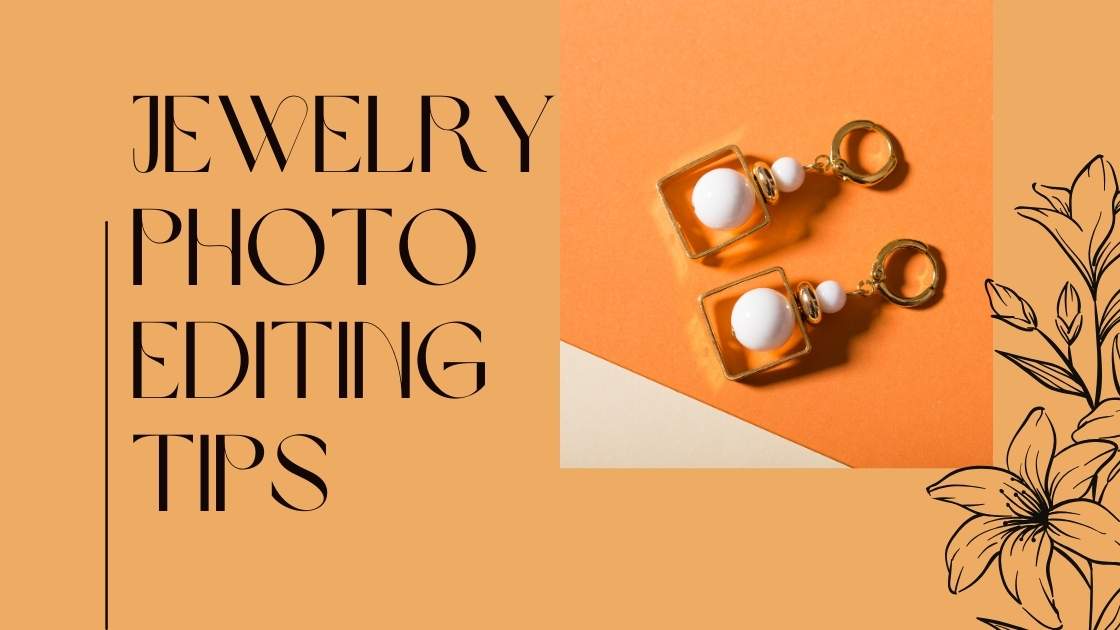In today’s e-commerce business, showcasing stunning product photography is extremely important. The competition is rising daily, and you must grab customer attention to generate sales. You must focus on your product photo display areas along with other strategies. When it comes to jewelry photos, you must pay more attention to create attractive visuals. That’s where jewelry photo editing comes in.
In this article, we will share some jewelry photo editing tips to maximize sales for your jewelry e-commerce business.
So, let’s start.
Why Jewelry Photo Editing Is Important?
Before starting, knowing why you should use post-production techniques on jewelry photos is important. Jewelry photography is more difficult rather than other photography. Photographers face challenges capturing intricate details as metals, stones, and gems are highly reflective. After all preparations, create sales-worthy product images without photo editing.
Below, we share some important reasons to use jewelry photo editing techniques:
- Enhancing Visual Appeal:
Jewelry is all about aesthetics. Creative editing helps make the pieces look as dazzling as they are in reality. Adjusting brightness, contrast, and colors ensures the jewelry appears vibrant and attractive, capturing the viewer’s attention.
- Removing Imperfections:
Jewelry often has tiny imperfections. It may not be visible to the naked eye. When you close up the photographs, you can identify them. Editing removes these imperfections. It also ensures that the product looks flawless and pristine.
- Consistency:
Editing allows for a consistent look across a jewelry collection. This uniformity helps in branding and creates a professional image for the jewelry brand. It also instills trust in potential customers.
- Detail Highlighting:
Editing can emphasize the intricate details and craftsmanship of jewelry, showcasing the unique features that make each piece special.
- Online Marketing:
In an era of online shopping, high-quality images are vital. Well-edited jewelry photos are more likely to stand out in e-commerce platforms, social media, and marketing materials, increasing the chances of sales.
- Customer Confidence:
Customers who see clear, professionally edited images are more confident in their purchasing decisions because they can better assess the jewelry’s quality and design.
Jewelry photo editing plays a pivotal role in presenting jewelry in the best possible light, both aesthetically and in terms of quality. It also contributes to the success of jewelry businesses in a competitive market.
Jewelry Photo Editing Tips for Creating Attractive Jewelry Photos
Exposure and white balance adjustment
Exposure and white balance correction are essential aspects of jewelry photo editing to ensure that the images accurately represent the jewelry’s colors and details.
When correcting exposure and white balance for jewelry photos, it’s important to maintain consistency across a product catalog, ensuring that all images have a uniform appearance.
- Exposure Correction: Change the brightness of jewelry photos.
- Underexposure: When jewelry photos are underexposed (too dark), editors increase the overall brightness of the photos. It helps to bring out details that may be hidden in the shadows.
- Overexposure: Overexposed photos (too bright) can wash out the details and colors of jewelry. In this case, editors reduce the brightness and recover lost details.
- Histogram Adjustment: Histograms visually represent the distribution of tones in an image. Adjusting the histogram helps to achieve the desired exposure balance.
- White Balance Correction: Adjust two major components, temperature and tint.
- Color Temperature: Jewelry items may appear with unnatural color casts due to incorrect lighting conditions. White balance correction involves adjusting the color temperature to ensure the colors are accurate. You can use a temperature slider to adjust the temperature for a neutral look.
- Color Calibration: Jewelry photos often require precise color calibration to ensure gemstones, metals, and other materials appear as they do in real life. Editing tools can be used to fine-tune color accuracy.
- Tint Slider: The tint slider allows precise adjustment of image color balance. It helps to play tweaks by adding green or magenta, enabling fine-tuning color accuracy and aesthetic preferences.
Change the background of the image:
Sometimes, you may need to change the existing background of your jewelry photos. This scenario often comes.
- When you sell products on e-commerce marketplaces like Amazon, eBay, Etsy, and more
- When you have one brand color and want to showcase products in your store using that brand color
- When you need a transparent background so that you may use multiple background colors. Especially for marketing campaigns, social media posting, and more.
Changing background can help each stage. However, the best way of changing the background from jewelry is by using clipping path service techniques. This is the most proven and effective way.
Here is the way of creating clipping path in photoshop
- Find the pen tool from the tool panel
- Start drawing the path from the one-pixel inner of the image.
- give a name and save it
- create a selection of the path
- Finally, create clipping mask to isolate the background from the image.
Add a Shadow Effect
If you create white background jewelry photos, you must add a shadow effect to make it more stunning. A well-executed shadow effect gives the jewelry a sense of dimension and depth. It separates the item from the background and makes it stand out, drawing the viewer’s attention.
Additionally, accurate shadows create visual interest and drama in jewelry photos. They can make the jewelry appear more elegant and luxurious, which can significantly attract potential buyers.
There are several ways you may use shadows on your jewelry photos.
- Drop shadow
- Reflection shadow
- Floating shadow
- Natural shadow.
How to add shadows in jewelry photos
You can add shadows on your jewelry photos by following the below steps
- Select the Jewelry: Select the jewelry item to which you want to apply the 3D shadow effect.
- Duplicate the Selection: Copy and paste the selected jewelry onto a new layer. This new layer will become the shadow layer.
- Position the Shadow: Move the shadow layer slightly below and to the side of the original jewelry item to mimic the direction of the light source casting the shadow. Ensure that the shadow aligns with the jewelry’s shape.
- Adjust Opacity: Lower the opacity of the shadow layer to make it semi-transparent. This opacity adjustment ensures that the shadow appears more realistic and subtle.
- Apply a Blur: Apply a Gaussian blur or a softening filter to the shadow layer. The blur should be gentle, as overly sharp shadows can look unnatural. Experiment with the blur intensity to achieve the desired effect.
- Fine-Tune Shadow Properties: Experiment with the shadow layer’s opacity, blur intensity, and positioning until the shadow looks natural and complements the jewelry. Adjust the shadow color if necessary to match the scene’s lighting.
- Layer Order: Make sure the shadow layer is positioned below the original jewelry layer in your image editing software. This arrangement ensures that the shadow appears beneath the jewelry.
- Refine and Save: Continuously refine the shadow until it enhances the jewelry’s 3D appearance without overpowering it. Once you are satisfied, save the edited jewelry photo.
Do Color Correction to create a Great Look.
Color correction is very crucial in jewelry photography. The aim is to ensure that the colors of the jewelry items in images accurately represent their real-life appearance. However, editors need a keen eye and precision to do it accurately.
There are several methods of doing color correction for jewelry photos. Below, I am showing a way to change the colors of the product image.
- Open images in Photoshop
- Select the Hue/saturation tool from the tool panel. [ this tool is hidden in layer> new adjustment layer]
- Use the pointer icon to select the color you want to change and click on it.
- The hue is for color selection. Use it to select your desired color. The saturation tool will help to set color vibrancy.
- Use a brush tool so that the effects may not appear on other elements of the images.
Fix imperfections using retouching techniques.
When it comes to jewelry photography, nobody can guarantee to keep it spotless. Photo retouching is crucial in fixing these imperfections and showcasing jewelry products in the best possible way. It enhances visual appeal, realism, and consistency, ultimately influencing customer perception and purchasing decisions in a highly competitive market.
You may use a few tools in Photoshop for retouching jewelry photography. Here are the two best tools for jewelry photo retouching.
- Spot Healing Brush Tool: This tool automatically samples nearby pixels to replace imperfections seamlessly.
- Clone Stamp Tool: This tool can clone any image elements and hide unwanted elements from photos.
Focus on areas while retouching photos.
Dust and Scratches Removal: Use the healing brush or clone stamp tool to remove visible dust, scratches, or blemishes from the jewelry’s surface.
Gemstone Enhancement: Enhance the appearance of gemstones by adjusting their brightness, contrast, and saturation.
Metal Polishing: Refine the look of metal surfaces by smoothing out any irregularities. Use the dodge and burn tools or manual brushing techniques to create a uniform, polished appearance.
Reflection Cleanup: Eliminate unwanted reflections or glares on the jewelry’s surface, especially if they obscure details. Carefully edit the reflections to enhance the jewelry’s visibility without losing the natural highlights.
Jewelry Photo Editing FAQ
How do you edit jewelry photos?
Generally, we start with background removal. After cleaning up the background, we add shadows on the product and retouch images to make it visually appealing.
Which Software is best for jewelry retouching?
We use Adobe Photoshop for retouching jewelry photos. Sometimes, we also use Adobe Lightroom.
Can you suggest some jewelry retouching software names?
We use Photoshop and Lightroom in our practical cases. However, you may try also
- Snapseed
- Photoshop Express


